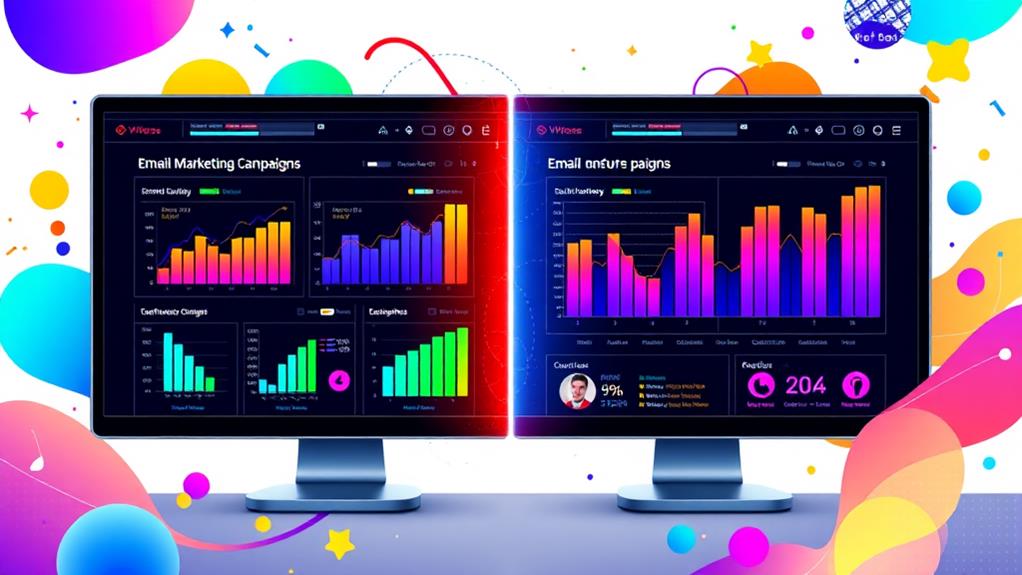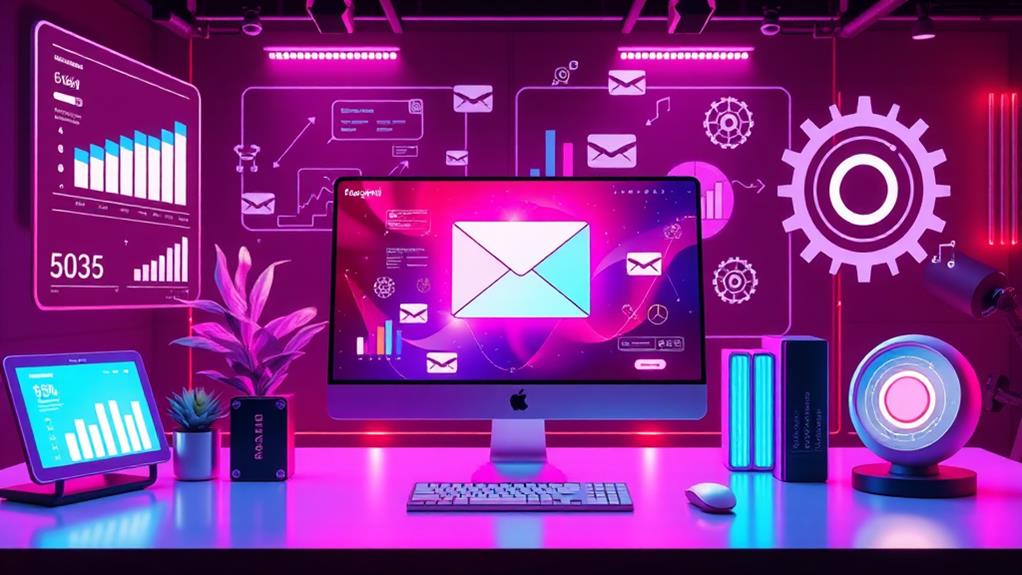Building long-term customer loyalty through email marketing involves strategic personalization and dynamic segmentation. By analyzing behavioral data, businesses can tailor emails, increasing transaction rates by up to six times. Utilizing purchase history for recommendations and targeting cart abandoners enhances perceived value and recovers lost sales. Loyalty programs, effectively communicated via email, boost retention rates and customer spend considerably. Furthermore, engaging with brand culture and social initiatives through email fosters emotional connections, with user-generated content influencing 79% of consumers. Ideal timing and frequency guarantee high engagement without causing customer fatigue. Explore further to enhance your email marketing strategies.
Key Takeaways
- Personalize email content to enhance emotional connections and increase transaction rates by up to six times.
- Segment email lists based on purchase history for targeted and effective messaging.
- Utilize loyalty programs to significantly boost customer retention and spending.
- Optimize email timing, sending on Tuesdays or Thursdays between 9-11 AM for higher engagement.
- Highlight user-generated content and social initiatives to build community and foster brand loyalty.
Understanding Customer Loyalty
Understanding customer loyalty is vital for any brand seeking sustainable growth and profitability. At its core, customer loyalty measures the strength of the relationship between a brand and its customers. Loyal customers, who prefer repeat purchases over exploring alternatives, are the backbone of a thriving business. Meeting customer expectations and maintaining high-quality offerings are essential strategies for fostering this loyalty.
Additionally, customer retention is notably more cost-effective than acquisition, with research showing that acquiring a new customer can be up to five times more expensive.
Loyalty metrics serve as important indicators of brand health, providing insights into customer satisfaction and the effectiveness of retention strategies. Brands that excel in these metrics often see loyal customers driving sales through repeat purchases. Indeed, loyal customers are five times more likely to make repeated transactions compared to new customers, underscoring the value of a robust loyalty strategy.
Furthermore, high customer retention rates can lead to increased profitability as these customers often become brand advocates, enhancing a brand's reach through organic word-of-mouth marketing.
Personalization and Segmentation
Incorporating tailored email content through the strategic use of behavioral data can greatly enhance customer engagement, with transaction rates potentially multiplying by a factor of six.
By employing dynamic audience segmentation, businesses can deliver highly relevant messages that resonate with individual preferences, leading to improved satisfaction and retention.
Furthermore, A/B testing these personalized strategies guarantees optimization, fostering stronger brand-customer relationships and maximizing the effectiveness of email marketing efforts.
Tailored Email Content
Harnessing the power of personalization and segmentation in email marketing can greatly amplify customer loyalty and engagement. Email personalization, by crafting messages that resonate with individual needs and preferences, can yield a six-fold increase in transaction rates. This tailored approach is vital, given that 72% of consumers prefer interacting with brands that provide personalized communication. By addressing recipients by name and recommending products aligned with past behaviors, companies can enhance emotional connections and foster long-term loyalty.
Segmentation further refines this strategy by categorizing email lists based on factors such as purchase history, engagement levels, and demographics. This allows businesses to deliver targeted messaging, markedly boosting customer engagement rates and retention. For instance, a segment of frequent buyers might receive exclusive offers, while less engaged customers could be enticed with special incentives to re-engage.
Strategically utilizing customer data for personalization and segmentation not only enhances user experience but also strengthens brand loyalty. A/B testing subject lines and content is essential in optimizing these strategies, enabling brands to discern what resonates best with different audience segments.
This data-driven approach guarantees that tailored email content remains relevant and impactful, ultimately driving sustained customer loyalty.
Behavioral Data Utilization
Effectively leveraging behavioral data in email marketing is a strategic game-changer, offering brands the opportunity to enhance personalization and segmentation efforts considerably. By analyzing behavioral triggers such as purchase frequency, cart abandonment, and engagement metrics, brands can tailor their messaging to meet the specific needs and preferences of different customer segments.
This data-driven approach not only boosts transaction rates—up to six times higher for personalized emails compared to non-personalized ones—but also fosters a deeper emotional connection with customers.
Segmenting email lists based on customer behaviors allows brands to deliver highly relevant content that resonates with distinct groups, thereby increasing customer satisfaction and loyalty. For instance, targeting cart abandoners with personalized reminders and incentives can recapture 3% to 14% of potential lost sales, while utilizing purchase history for product recommendations enhances customer perception of being understood and valued.
Additionally, advanced segmentation strategies lead to improved engagement metrics, with loyalty program emails achieving a 14% higher open rate than standard marketing emails.
These insights underscore the importance of using behavioral data not just to enhance immediate sales, but to cultivate long-term customer relationships through strategic personalization and segmentation.
Dynamic Audience Segmentation
While the digital marketing landscape continues to evolve, dynamic audience segmentation emerges as a pivotal strategy for enhancing email marketing effectiveness. By utilizing audience analysis and segmentation strategies, businesses can tailor their email campaigns to meet the specific needs and preferences of their customers. This approach not only results in an impressive 14% increase in open rates and a 10% higher click-through rate but also fosters long-term customer loyalty.
Dynamic audience segmentation involves categorizing customers based on criteria such as purchase frequency and engagement levels. Such segmentation strategies enable personalized messaging, which can improve conversion rates by up to six times. Additionally, personalizing emails, for instance, by addressing customers by name or recommending products based on past purchases, greatly boosts engagement, with 72% of consumers expressing a preference for personalized communication.
Effective segmentation of email lists allows marketers to create targeted campaigns that resonate with different customer groups, leading to a 58% higher ROI for email marketing efforts. Moreover, conducting A/B testing on different segments helps refine messaging strategies and optimize performance, ensuring that businesses address the unique needs of their audiences.
- Increased open rates by 14%
- Higher click-through rates by 10%
- 72% preference for personalized communication
- 58% higher ROI through targeted campaigns
Building Brand Community
Building a brand community through email marketing involves strategically highlighting user-generated content, which resonates with 79% of consumers and greatly influences purchasing decisions.
By incorporating stories of social initiatives and employee spotlights, brands can enhance relatability and align with the values of socially conscious consumers, fostering deeper engagement.
Additionally, cultivating brand culture with interactive elements such as polls and surveys in emails not only encourages active participation but also strengthens customer loyalty by making them feel integral to the brand's narrative.
Cultivating Brand Culture
Crafting a robust brand culture is pivotal in establishing a devoted customer base and can be greatly augmented through email marketing strategies. By leveraging brand storytelling and community engagement, businesses can create an emotional connection with their audience.
Highlighting user-generated content not only humanizes the brand but also impacts purchasing decisions for 79% of consumers. This approach can be seamlessly integrated into email campaigns, fostering a sense of community and belonging.
Additionally, consistently sharing your brand's philanthropic efforts can resonate with socially conscious consumers. With 70% of millennials willing to pay more for brands aligning with their values, showcasing these initiatives in emails can greatly bolster brand loyalty.
Moreover, featuring employee spotlights personalizes the brand experience, as customers tend to form deeper connections with businesses that showcase their team members.
To effectively cultivate brand culture through email marketing, consider the following strategies:
- Highlight user-generated content: Engage consumers by showcasing their contributions, enhancing community ties.
- Communicate philanthropic efforts: Align with values, attracting socially conscious customers.
- Feature employee spotlights: Personalize the brand, boosting customer engagement.
- Offer exclusivity: Use special offers and loyalty programs to recognize and reward valued customers.
These strategic elements can enhance brand culture, fostering long-term customer loyalty.
Encouraging User Contributions
An effective strategy to bolster brand community involves encouraging user contributions, which not only fosters engagement but also builds trust and authenticity. By integrating user-generated content into email marketing, brands can create a powerful sense of community.
Importantly, 79% of consumers acknowledge that user-generated content greatly influences their purchasing decisions. This approach can be seamlessly implemented by featuring customer experiences in newsletters, thereby enhancing the perceived authenticity of the brand.
Encouraging customers to share their experiences through social media or product reviews can further amplify brand visibility and credibility. With 86% of consumers prioritizing authenticity in brand choice, leveraging these customer experiences is essential.
Implementing interactive initiatives, such as contests or challenges, can also greatly boost engagement. A striking 65% of users express a higher likelihood of engaging with brands that encourage such participation.
To deepen brand loyalty, consider dedicating a section in emails to customer stories or testimonials. This strategy not only makes customers feel valued but also strengthens their connection to the brand community.
Additionally, offering incentives like discounts or loyalty points for contributions can enhance participation. This strategy not only fosters a loyal customer base but also increases retention rates, reinforcing long-term brand success.
Highlighting Social Initiatives
Incorporating social initiatives into email marketing strategies can greatly enhance brand community by aligning the company with causes that resonate deeply with socially conscious consumers. This alignment can lead to increased loyalty and engagement, as consumers feel part of a community making a tangible social impact.
By sharing stories of your brand's philanthropic efforts, you not only humanize your company but also foster a deeper emotional connection with your audience. Consistently communicating these initiatives can reinforce brand values, appealing to the 66% of consumers who prefer brands that reflect their personal beliefs.
An effective way to bolster community engagement is through incorporating user-generated content related to social initiatives in your newsletters. This approach can notably influence purchasing decisions, with 79% of consumers citing such content as impactful.
In addition, engaging customers through interactive content, like polls or feedback requests, can enhance their sense of involvement and investment in the brand community.
- Increase authenticity: Showcase real stories and outcomes to build trust.
- Foster emotional connections: Share narratives that align with consumer values.
- Encourage participation: Use interactive elements to boost engagement.
- Highlight impact: Regularly update on progress and achievements.
Leveraging Loyalty Programs
Loyalty programs stand as a cornerstone for improving customer retention, offering a strategic advantage to businesses aiming to optimize marketing expenditures. By implementing robust reward structures and carefully designed program tiers, businesses can considerably increase retention rates—by as much as 5 to 25 times compared to acquiring new customers.
These programs not only save on marketing costs but also boost sales, as evidenced by the 67% higher spending of loyalty program participants compared to first-time buyers.
Strategically leveraging email marketing to communicate loyalty program benefits is essential. Loyalty emails that highlight exclusive rewards and personalized incentives can outperform standard marketing emails by 14 times, driving higher engagement and encouraging repeat purchases.
This approach is further validated as 49% of engaged loyalty program members report increased spending, underscoring the financial benefits of a well-executed loyalty initiative.
To improve the effectiveness of these programs, businesses should utilize data analytics to track customer interactions with loyalty emails. This data-driven approach allows for the refinement of marketing strategies, ensuring that communications resonate with customers and enhance their loyalty experience.
Effective Email Timing
While loyalty programs provide a solid framework for enhancing customer retention, the timing of email communications plays an equally vital role in maximizing their impact.
Strategic consideration of ideal timing is essential. Research indicates that sending emails on Tuesday or Thursday between 9-11 AM notably boosts engagement, as these times exhibit higher open rates. This data-driven approach guarantees that your message reaches customers when they are most receptive.
Additionally, managing email frequency is important to avoid customer fatigue. Over-communicating can lead to higher unsubscribe rates and reduced engagement. Striking the right balance is critical for maintaining customer interest and loyalty. Regular newsletters can effectively inform and engage without overwhelming recipients.
Monitoring open rates is a powerful tool in determining the ideal email frequency for your audience. By analyzing these metrics, businesses can fine-tune their strategies to align with recipient behavior.
Finally, when targeting a global audience, time zone consideration is essential. Delivering emails at the appropriate local time can notably enhance reach and engagement.
- Ideal send times: Tuesday/Thursday, 9-11 AM
- Avoid excessive frequency to prevent fatigue
- Monitor open rates to adjust frequency
- Consider time zones for global audiences
Retention Email Strategies
Retention email strategies are imperative in fortifying customer loyalty, as statistics reveal that a substantial 65% of a company's revenue is generated by existing customers. To capitalize on this, businesses must employ effective retention tactics that focus on personalized communication. By tailoring emails to individual customer behaviors and preferences, transaction rates can surge by up to six times. This personalization is essential in maintaining and enhancing engagement metrics, ensuring customers remain connected with the brand.
Re-engagement emails play a key role in this strategy, particularly when reminding customers of abandoned carts. Such emails can recover between 3% and 14% of lost sales, effectively turning potential losses into valuable revenue streams.
Moreover, the implementation of loyalty program emails markedly outperforms regular marketing emails, achieving 14 times higher engagement rates. These emails are powerful tools for driving repeat purchases and nurturing long-term customer relationships.
In addition, regularly sending thank you emails post-purchase can reinforce positive feelings towards the brand. Expressing gratitude not only enhances customer satisfaction but also strengthens their loyalty, encouraging future business.
Measuring Campaign Success
In building a robust email marketing strategy, understanding the effectiveness of retention efforts requires a meticulous approach to measuring campaign success.
Utilizing email analytics is paramount in this endeavor, as it enables marketers to decipher performance metrics that reveal how well campaigns are resonating with their audience. Key metrics such as open rates, which generally hover between 20-30%, are critical for gauging initial interest.
Meanwhile, click-through rates (CTR), averaging 2-5%, offer deeper insights into engagement and the persuasive power of your content. Equally important is monitoring conversion rates, which track the percentage of recipients completing desired actions, providing a thorough view of campaign efficacy.
Analyzing unsubscribe rates is also indispensable; rates exceeding 0.5% can signal possible content or frequency misalignments, necessitating strategic adjustments.
To enhance performance, implementing A/B testing can yield significant improvements. By experimenting with various subject lines, layouts, or content strategies, brands have reported conversion boosts of up to 49%.
- Open Rates: Measure initial interest.
- Click-Through Rates: Evaluate engagement effectiveness.
- Conversion Rates: Assess overall campaign success.
- Unsubscribe Rates: Identify content relevance issues.
Through strategic use of performance metrics and email analytics, marketers can refine their efforts and foster long-term customer loyalty.
Frequently Asked Questions
How Does Email Marketing Increase Customer Loyalty?
Email marketing enhances customer loyalty through personalized content and targeted campaigns, achieving higher engagement rates and transaction increases. This strategic approach fosters direct communication, offering exclusive benefits that strengthen customer relationships and drive significant revenue growth.
How to Create Long-Term Loyalty With Customers?
To create long-term loyalty with customers, employ customer engagement strategies that incorporate personalized content approaches. Tailor communications to individual preferences, leverage data-driven insights, and consistently deliver value to strengthen relationships and enhance brand commitment, fostering lasting loyalty.
How Can Marketers Keep Customers Loyal Longer?
Marketers can extend customer loyalty by delivering personalized content and strategically implementing loyalty programs. Data-driven insights suggest such approaches increase transaction rates and retention, fostering deeper emotional connections and greatly enhancing lifetime customer value through tailored email campaigns.
How Do You Retain Customers Through Email Marketing?
To retain customers through email marketing, employ customer engagement strategies incorporating personalized content techniques. Utilize data-driven insights to craft tailored messages, enhancing relevance and connection, thereby fostering long-term loyalty and driving sustained business growth strategically.
Conclusion
To summarize, cultivating long-term customer loyalty through email marketing necessitates a strategic blend of personalization, segmentation, and community-building. Employing effective loyalty programs and optimizing email timing are critical components in maintaining engagement. Retention strategies should be continuously refined based on data-driven insights to enhance effectiveness. By systematically measuring campaign success, businesses can adapt their approaches to meet evolving consumer preferences, thereby ensuring sustained loyalty. This strategic focus on data and personalization is essential for enduring customer relationships.




